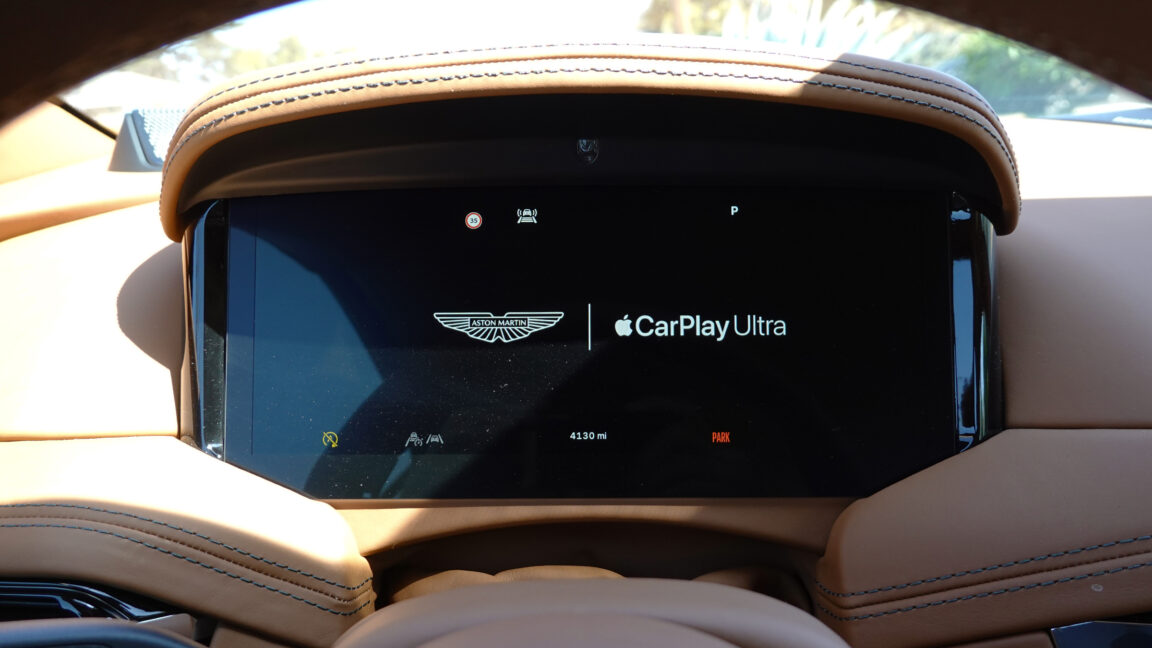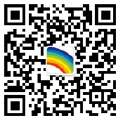
Credit: Michael Teo Van Runkle
For the 2025 model year, Aston Martin's user interface took a major step forward across the lineup, with improvements to the physical controls and digital infotainment, as well as updated gauge cluster layouts. However, the big news dropped in the spring, when Aston and Apple announced the launch of CarPlay Ultra, the next generation of Apple's nearly ubiquitous automotive operating system.
Ultra extends beyond the strictly “phone” functions of traditional CarPlay to now encompass more robust vehicular integration, including climate control, drive modes, and the entire gauge cluster readout. Running Ultra, therefore, requires a digital gauge cluster. So far, not many automakers other than Aston have signaled their intent to join the revolution: Kia/Hyundai/Genesis will adopt Ultra next, and Porsche may come after that.
Before future partnerships come to fruition, I spent a week with a DB12 Volante to test Ultra's use cases and conceptual failure points, most critically to discover whether this generational leap actually enhances or detracts from an otherwise stellar driving experience.
Setup
Connecting to Ultra via Bluetooth takes a minute or two longer than traditional CarPlay and includes more consent screens to cover the additional legal ramifications of the operating system sharing data with the car, and vice versa. Apple restricts this data to multimedia info, plus real-time speed and engine status, vehicle lights, and similar functions. Specifically, neither the iPhone nor third-party apps store any vehicle data after disconnecting from the car, and the car doesn't keep personal data once the iPhone disconnects, either.
What about Siri? I generally keep Siri turned off so that accidental “Hey, Siri” activations don't constantly interrupt my life—but by pushing the DB12's steering wheel button, I could test simple tasks that went just about as well as typical for Siri (read: don't expect much “Apple Intelligence” quite yet). Standard Siri data sharing with Apple therefore applies when used with Ultra.
I tested Ultra with an iPhone 16 Pro, but the software requires an iPhone 12 or newer and the latest iOS 18.5 update. As a type of simple failure exercise, I turned my phone off while driving more than once. Doing so reverts both the gauge cluster and infotainment screen to Aston's native UI, the former almost instantly and the latter just a few seconds later. However, once I turned my phone back on, I struggled to reactivate either traditional CarPlay or Ultra until I forgot the device in my Bluetooth settings and started over from scratch. This held true for every attempt.
Once initiated, though, Ultra fired up straightaway every time. Much faster than the typical lag to boot up traditional CarPlay. In fact, as soon as I unlocked the doors but before entering the DB12, the gauge cluster showed Ultra's Apple-style readouts. These configurable designs, which Apple developed with Aston's input, include a classic analog-style gauge view as well as layouts that allow for minimized data, navigation, and stylistic choices selectable through the center console screen or by swiping the haptic button on the DB12's steering wheel.
Call me old-fashioned, but I still enjoy seeing a tachometer, speedometer, drive modes, and fuel level versus range remaining and a digital speed—especially on an engaging performance vehicle like the DB12 Volante. Apple might be skilled at making new tech easy to use, but it's hard to beat the power of millions of minds adapting to analog gauges over the past century or so. And in this case, Ultra's tach(s) showed a bit of latency or lag while ripping that 671-hp twin-turbo V8 up through the revs, something I never noticed in the native UI.
It’s much more holistic now
Ultra's biggest improvements over preceding CarPlay generations are in the center console infotainment integration. Being able to access climate controls, drive modes, and traction settings without leaving the intuitive suite of CarPlay makes life much easier. In fact, changing between drive modes and turning traction control off or down via Aston's nifty adjustable system caused less latency and lagging in the displays in Ultra. And for climate, Ultra actually brings up a much better screen after spinning the physical rotaries on the center console than you get through Aston's UI—plus, I found a way to make the ventilated seats blow stronger, which I never located through the innate UI despite purposefully searching for a similar menu page.
Some specific functions do require dipping out of Ultra, though, including changing any audio settings for the spectacular Bowers & Wilkins sound system. I also found two glitches. Trying to bring down the DB12 Volante's convertible top cued up a “Close trunk separator” alert, but the only way to close the trunk separator is via the same button as the convertible top. So instead, the windows only went up and down repeatedly as I tried to enjoy open-top motoring. This happened both in Ultra and without, however, so it could just be an Aston issue that Ultra couldn't fix.
Plus, over the course of my eight days with Ultra, I experienced one moment where both the infotainment and gauge cluster went totally black. This resembled GM's Ultium screen issues and lasted about 30 seconds or so before both flickered to life again. At first, I suspected an inadvertent attempt to activate nighttime driving mode. But again, this could have been an Aston issue, an Apple issue, or both.
Running around Los Angeles, I never found a spot with zero reception (I run e-sims, both Verizon and AT&T simultaneously, for this very reason), but I did purposefully enter airplane mode. This time, Ultra stayed active, and regardless, Apple assured me that essential functions, including navigation, can pre-load offline data for planned route guidance. But at the very worst, as with the phone turning off or battery dying, Ultra can simply revert to the onboard navigation.
Using Ultra regularly seemed to deplete my iPhone's battery slightly more quickly than normal, and I noticed some warming of the iPhone—though without a controlled experiment, I can't say with certainty whether these two symptoms happened quicker than simply running traditional CarPlay or Bluetooth. And in reality, most cars running Ultra (for Aston and beyond) should come equipped with wireless charge pads and plenty of USB-C ports anyhow to keep those batteries topped up. On hot summer days in LA, though, my iPhone seemed to get warmest while using inductive charging and Ultra simultaneously, to my admittedly unscientific touch.
For commuters who brave traffic using Advanced Driver Assistance Systems (ADAS), Ultra seemed to work smoothly with the DB12's lane departure warnings, steering corrections, and adaptive cruise control—though I typically turn all this off via Aston's handy single button, which helps to stave off frustration. This introduces a loophole or gap in regulations, however, whether CarPlay Ultra needs to meet the ISO's ASIL-D standards or achieve some kind of National Highway Traffic Safety Administration certification.
Traditional CarPlay stuck with infotainment and basic “phone” functions, but now that the iPhone essentially accesses and displays ADAS, drive modes, and traction setting information, where does regulated consumer safety come in? And where does liability rest, in the event of a driver aid or corrective maneuver going awry? Somehow, this question seems most likely to wind up on the desk of an insurance adjuster sooner rather than later.
Can we try it in an EV?
For me, some disappointment arose from being unable to cue up either Waze or Google Maps in Ultra's gauge cluster navigation screens rather than strictly Apple Maps. But in many ways, I suspect that Ultra might work even better when (or if) Hyundai/Kia/Genesis introduce compatible EVs, rather than Aston's (so far) more classic ICE vehicles. And not just because the modern futurist aesthetic matches better, either, but more so thanks to the improved accuracy of range, charging, and navigation features.
The center infotainment screen's integration with vehicular functions, therefore, stands out as much more of a pro for Aston Martins than Ultra's gauge cluster readout, enhancing the driving experience through a more intuitive UI that decreases time spent glancing away from the road. For those who want to skip out on Ultra, it's also worth noting that the iPhone allows for the choice to stick with traditional CarPlay only as well. However, I suspect car buyers will eventually begin to expect Ultra, even if the added jump to vehicular control represents somewhat less of a massive leap than simply picking between models equipped with CarPlay or not.
It's unclear whether other automakers will find the advantages worthy of converting to Ultra, including Rivian, which offers neither CarPlay nor Android Auto, or GM, which skipped out on CarPlay for EVs. On the other hand, automakers may also decide to hesitate before handing over further control to Apple now that the Apple Car is officially dead. And in that regard, Ultra might just represent the final straw that inspires further improvements to proprietary user interfaces across the industry as well.

-
 C114 Communication Network
C114 Communication Network -
 Communication Home
Communication Home


